Escape from middle income trap in Malaysia
VerifiedAdded on 2023/04/10
|11
|2418
|385
AI Summary
This article discusses the concept of middle income trap and focuses on the challenges faced by Malaysia in escaping it. It explores the causes of middle income trap and provides strategies to overcome it. The article also highlights the role of government in avoiding middle income trap.
Contribute Materials
Your contribution can guide someone’s learning journey. Share your
documents today.

Running head: ECONOMICS
Economics
Name of the student
Name of the university
Author note
Economics
Name of the student
Name of the university
Author note
Secure Best Marks with AI Grader
Need help grading? Try our AI Grader for instant feedback on your assignments.
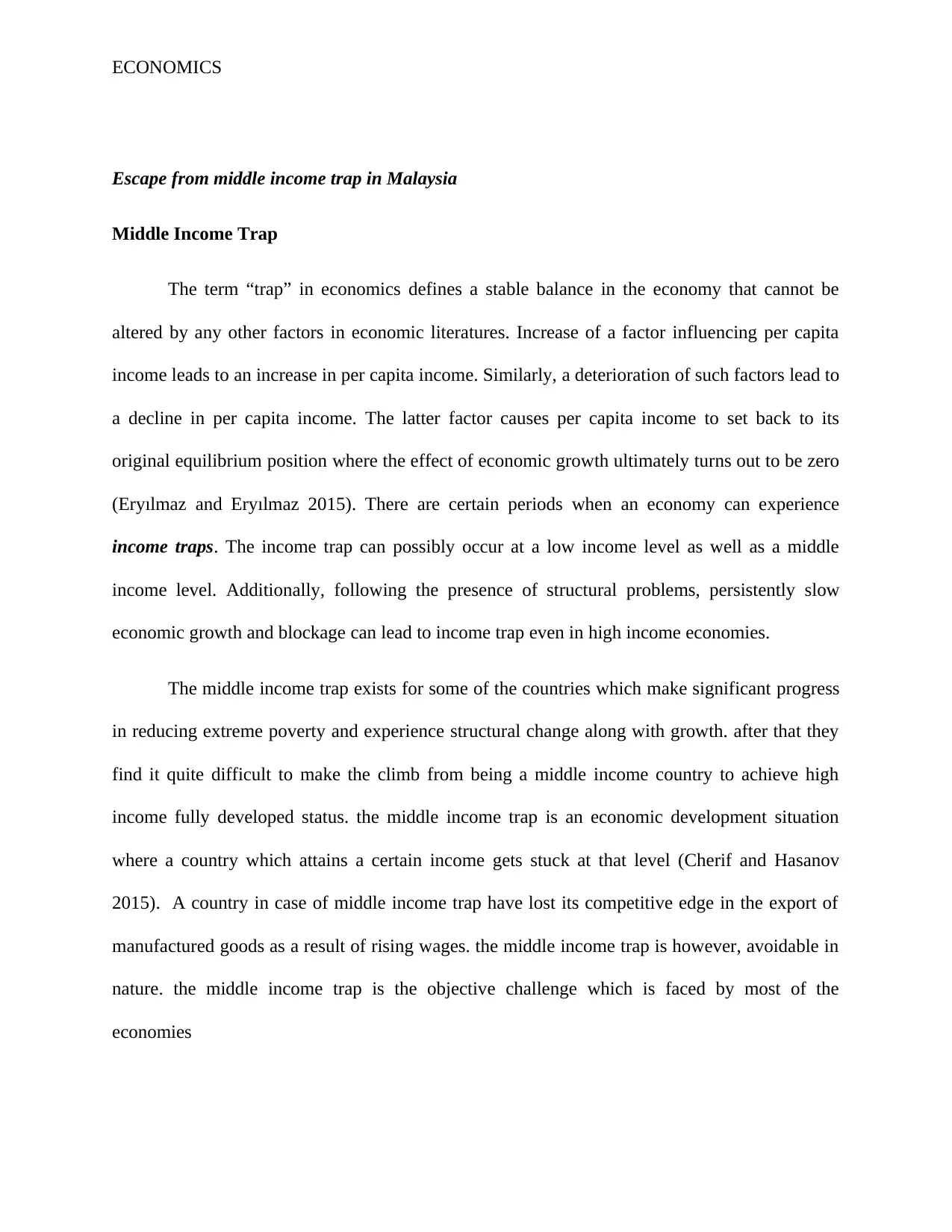
ECONOMICS
Escape from middle income trap in Malaysia
Middle Income Trap
The term “trap” in economics defines a stable balance in the economy that cannot be
altered by any other factors in economic literatures. Increase of a factor influencing per capita
income leads to an increase in per capita income. Similarly, a deterioration of such factors lead to
a decline in per capita income. The latter factor causes per capita income to set back to its
original equilibrium position where the effect of economic growth ultimately turns out to be zero
(Eryılmaz and Eryılmaz 2015). There are certain periods when an economy can experience
income traps. The income trap can possibly occur at a low income level as well as a middle
income level. Additionally, following the presence of structural problems, persistently slow
economic growth and blockage can lead to income trap even in high income economies.
The middle income trap exists for some of the countries which make significant progress
in reducing extreme poverty and experience structural change along with growth. after that they
find it quite difficult to make the climb from being a middle income country to achieve high
income fully developed status. the middle income trap is an economic development situation
where a country which attains a certain income gets stuck at that level (Cherif and Hasanov
2015). A country in case of middle income trap have lost its competitive edge in the export of
manufactured goods as a result of rising wages. the middle income trap is however, avoidable in
nature. the middle income trap is the objective challenge which is faced by most of the
economies
Escape from middle income trap in Malaysia
Middle Income Trap
The term “trap” in economics defines a stable balance in the economy that cannot be
altered by any other factors in economic literatures. Increase of a factor influencing per capita
income leads to an increase in per capita income. Similarly, a deterioration of such factors lead to
a decline in per capita income. The latter factor causes per capita income to set back to its
original equilibrium position where the effect of economic growth ultimately turns out to be zero
(Eryılmaz and Eryılmaz 2015). There are certain periods when an economy can experience
income traps. The income trap can possibly occur at a low income level as well as a middle
income level. Additionally, following the presence of structural problems, persistently slow
economic growth and blockage can lead to income trap even in high income economies.
The middle income trap exists for some of the countries which make significant progress
in reducing extreme poverty and experience structural change along with growth. after that they
find it quite difficult to make the climb from being a middle income country to achieve high
income fully developed status. the middle income trap is an economic development situation
where a country which attains a certain income gets stuck at that level (Cherif and Hasanov
2015). A country in case of middle income trap have lost its competitive edge in the export of
manufactured goods as a result of rising wages. the middle income trap is however, avoidable in
nature. the middle income trap is the objective challenge which is faced by most of the
economies
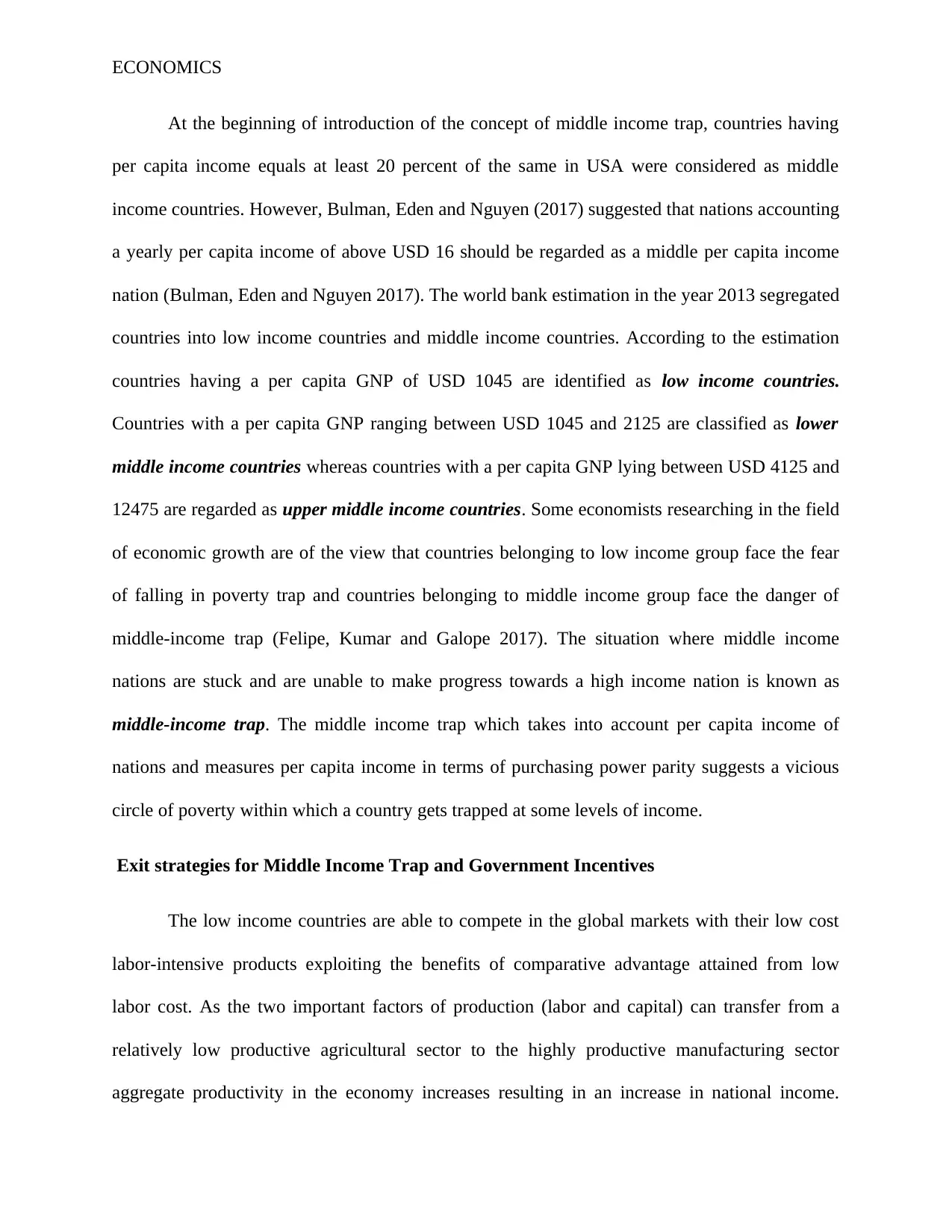
ECONOMICS
At the beginning of introduction of the concept of middle income trap, countries having
per capita income equals at least 20 percent of the same in USA were considered as middle
income countries. However, Bulman, Eden and Nguyen (2017) suggested that nations accounting
a yearly per capita income of above USD 16 should be regarded as a middle per capita income
nation (Bulman, Eden and Nguyen 2017). The world bank estimation in the year 2013 segregated
countries into low income countries and middle income countries. According to the estimation
countries having a per capita GNP of USD 1045 are identified as low income countries.
Countries with a per capita GNP ranging between USD 1045 and 2125 are classified as lower
middle income countries whereas countries with a per capita GNP lying between USD 4125 and
12475 are regarded as upper middle income countries. Some economists researching in the field
of economic growth are of the view that countries belonging to low income group face the fear
of falling in poverty trap and countries belonging to middle income group face the danger of
middle-income trap (Felipe, Kumar and Galope 2017). The situation where middle income
nations are stuck and are unable to make progress towards a high income nation is known as
middle-income trap. The middle income trap which takes into account per capita income of
nations and measures per capita income in terms of purchasing power parity suggests a vicious
circle of poverty within which a country gets trapped at some levels of income.
Exit strategies for Middle Income Trap and Government Incentives
The low income countries are able to compete in the global markets with their low cost
labor-intensive products exploiting the benefits of comparative advantage attained from low
labor cost. As the two important factors of production (labor and capital) can transfer from a
relatively low productive agricultural sector to the highly productive manufacturing sector
aggregate productivity in the economy increases resulting in an increase in national income.
At the beginning of introduction of the concept of middle income trap, countries having
per capita income equals at least 20 percent of the same in USA were considered as middle
income countries. However, Bulman, Eden and Nguyen (2017) suggested that nations accounting
a yearly per capita income of above USD 16 should be regarded as a middle per capita income
nation (Bulman, Eden and Nguyen 2017). The world bank estimation in the year 2013 segregated
countries into low income countries and middle income countries. According to the estimation
countries having a per capita GNP of USD 1045 are identified as low income countries.
Countries with a per capita GNP ranging between USD 1045 and 2125 are classified as lower
middle income countries whereas countries with a per capita GNP lying between USD 4125 and
12475 are regarded as upper middle income countries. Some economists researching in the field
of economic growth are of the view that countries belonging to low income group face the fear
of falling in poverty trap and countries belonging to middle income group face the danger of
middle-income trap (Felipe, Kumar and Galope 2017). The situation where middle income
nations are stuck and are unable to make progress towards a high income nation is known as
middle-income trap. The middle income trap which takes into account per capita income of
nations and measures per capita income in terms of purchasing power parity suggests a vicious
circle of poverty within which a country gets trapped at some levels of income.
Exit strategies for Middle Income Trap and Government Incentives
The low income countries are able to compete in the global markets with their low cost
labor-intensive products exploiting the benefits of comparative advantage attained from low
labor cost. As the two important factors of production (labor and capital) can transfer from a
relatively low productive agricultural sector to the highly productive manufacturing sector
aggregate productivity in the economy increases resulting in an increase in national income.
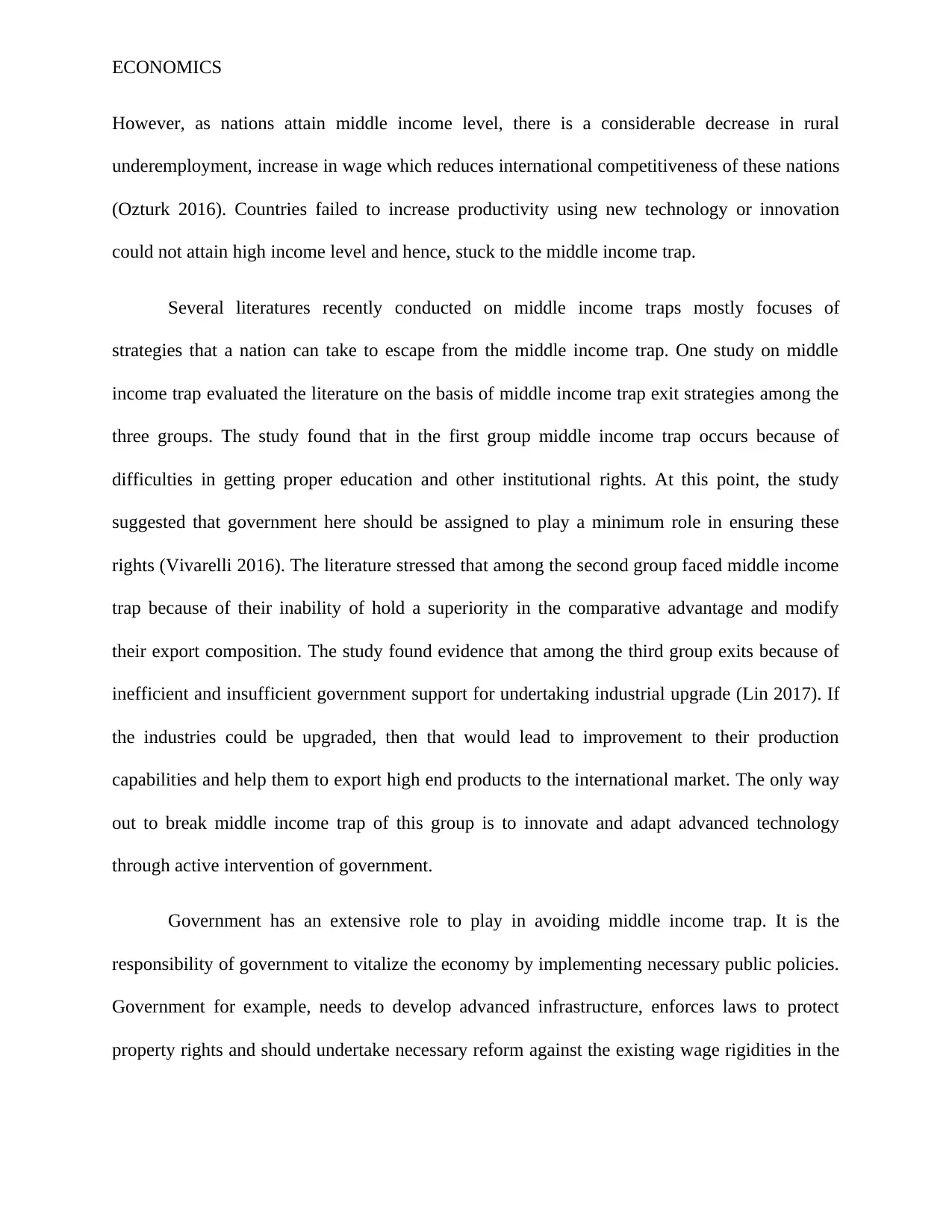
ECONOMICS
However, as nations attain middle income level, there is a considerable decrease in rural
underemployment, increase in wage which reduces international competitiveness of these nations
(Ozturk 2016). Countries failed to increase productivity using new technology or innovation
could not attain high income level and hence, stuck to the middle income trap.
Several literatures recently conducted on middle income traps mostly focuses of
strategies that a nation can take to escape from the middle income trap. One study on middle
income trap evaluated the literature on the basis of middle income trap exit strategies among the
three groups. The study found that in the first group middle income trap occurs because of
difficulties in getting proper education and other institutional rights. At this point, the study
suggested that government here should be assigned to play a minimum role in ensuring these
rights (Vivarelli 2016). The literature stressed that among the second group faced middle income
trap because of their inability of hold a superiority in the comparative advantage and modify
their export composition. The study found evidence that among the third group exits because of
inefficient and insufficient government support for undertaking industrial upgrade (Lin 2017). If
the industries could be upgraded, then that would lead to improvement to their production
capabilities and help them to export high end products to the international market. The only way
out to break middle income trap of this group is to innovate and adapt advanced technology
through active intervention of government.
Government has an extensive role to play in avoiding middle income trap. It is the
responsibility of government to vitalize the economy by implementing necessary public policies.
Government for example, needs to develop advanced infrastructure, enforces laws to protect
property rights and should undertake necessary reform against the existing wage rigidities in the
However, as nations attain middle income level, there is a considerable decrease in rural
underemployment, increase in wage which reduces international competitiveness of these nations
(Ozturk 2016). Countries failed to increase productivity using new technology or innovation
could not attain high income level and hence, stuck to the middle income trap.
Several literatures recently conducted on middle income traps mostly focuses of
strategies that a nation can take to escape from the middle income trap. One study on middle
income trap evaluated the literature on the basis of middle income trap exit strategies among the
three groups. The study found that in the first group middle income trap occurs because of
difficulties in getting proper education and other institutional rights. At this point, the study
suggested that government here should be assigned to play a minimum role in ensuring these
rights (Vivarelli 2016). The literature stressed that among the second group faced middle income
trap because of their inability of hold a superiority in the comparative advantage and modify
their export composition. The study found evidence that among the third group exits because of
inefficient and insufficient government support for undertaking industrial upgrade (Lin 2017). If
the industries could be upgraded, then that would lead to improvement to their production
capabilities and help them to export high end products to the international market. The only way
out to break middle income trap of this group is to innovate and adapt advanced technology
through active intervention of government.
Government has an extensive role to play in avoiding middle income trap. It is the
responsibility of government to vitalize the economy by implementing necessary public policies.
Government for example, needs to develop advanced infrastructure, enforces laws to protect
property rights and should undertake necessary reform against the existing wage rigidities in the
Secure Best Marks with AI Grader
Need help grading? Try our AI Grader for instant feedback on your assignments.
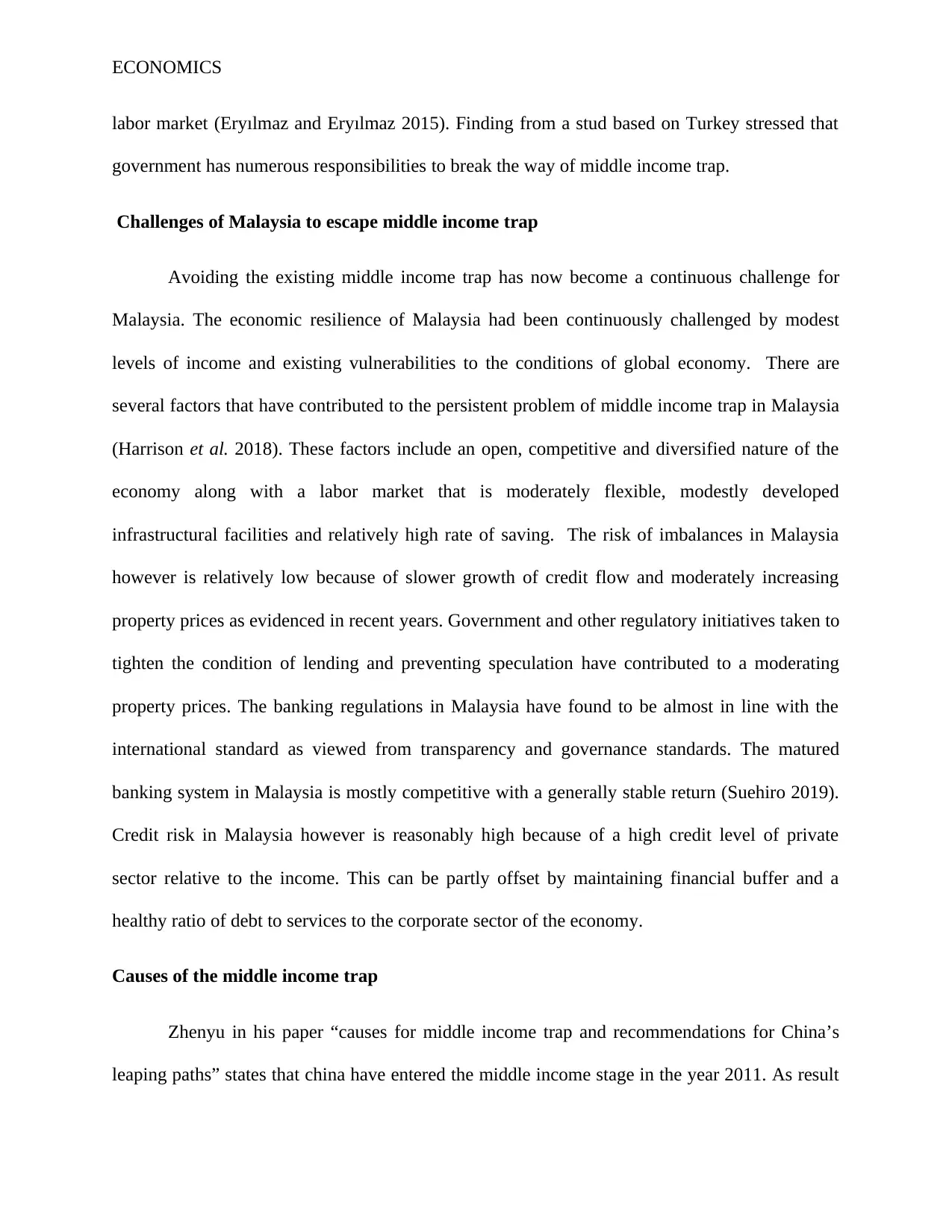
ECONOMICS
labor market (Eryılmaz and Eryılmaz 2015). Finding from a stud based on Turkey stressed that
government has numerous responsibilities to break the way of middle income trap.
Challenges of Malaysia to escape middle income trap
Avoiding the existing middle income trap has now become a continuous challenge for
Malaysia. The economic resilience of Malaysia had been continuously challenged by modest
levels of income and existing vulnerabilities to the conditions of global economy. There are
several factors that have contributed to the persistent problem of middle income trap in Malaysia
(Harrison et al. 2018). These factors include an open, competitive and diversified nature of the
economy along with a labor market that is moderately flexible, modestly developed
infrastructural facilities and relatively high rate of saving. The risk of imbalances in Malaysia
however is relatively low because of slower growth of credit flow and moderately increasing
property prices as evidenced in recent years. Government and other regulatory initiatives taken to
tighten the condition of lending and preventing speculation have contributed to a moderating
property prices. The banking regulations in Malaysia have found to be almost in line with the
international standard as viewed from transparency and governance standards. The matured
banking system in Malaysia is mostly competitive with a generally stable return (Suehiro 2019).
Credit risk in Malaysia however is reasonably high because of a high credit level of private
sector relative to the income. This can be partly offset by maintaining financial buffer and a
healthy ratio of debt to services to the corporate sector of the economy.
Causes of the middle income trap
Zhenyu in his paper “causes for middle income trap and recommendations for China’s
leaping paths” states that china have entered the middle income stage in the year 2011. As result
labor market (Eryılmaz and Eryılmaz 2015). Finding from a stud based on Turkey stressed that
government has numerous responsibilities to break the way of middle income trap.
Challenges of Malaysia to escape middle income trap
Avoiding the existing middle income trap has now become a continuous challenge for
Malaysia. The economic resilience of Malaysia had been continuously challenged by modest
levels of income and existing vulnerabilities to the conditions of global economy. There are
several factors that have contributed to the persistent problem of middle income trap in Malaysia
(Harrison et al. 2018). These factors include an open, competitive and diversified nature of the
economy along with a labor market that is moderately flexible, modestly developed
infrastructural facilities and relatively high rate of saving. The risk of imbalances in Malaysia
however is relatively low because of slower growth of credit flow and moderately increasing
property prices as evidenced in recent years. Government and other regulatory initiatives taken to
tighten the condition of lending and preventing speculation have contributed to a moderating
property prices. The banking regulations in Malaysia have found to be almost in line with the
international standard as viewed from transparency and governance standards. The matured
banking system in Malaysia is mostly competitive with a generally stable return (Suehiro 2019).
Credit risk in Malaysia however is reasonably high because of a high credit level of private
sector relative to the income. This can be partly offset by maintaining financial buffer and a
healthy ratio of debt to services to the corporate sector of the economy.
Causes of the middle income trap
Zhenyu in his paper “causes for middle income trap and recommendations for China’s
leaping paths” states that china have entered the middle income stage in the year 2011. As result
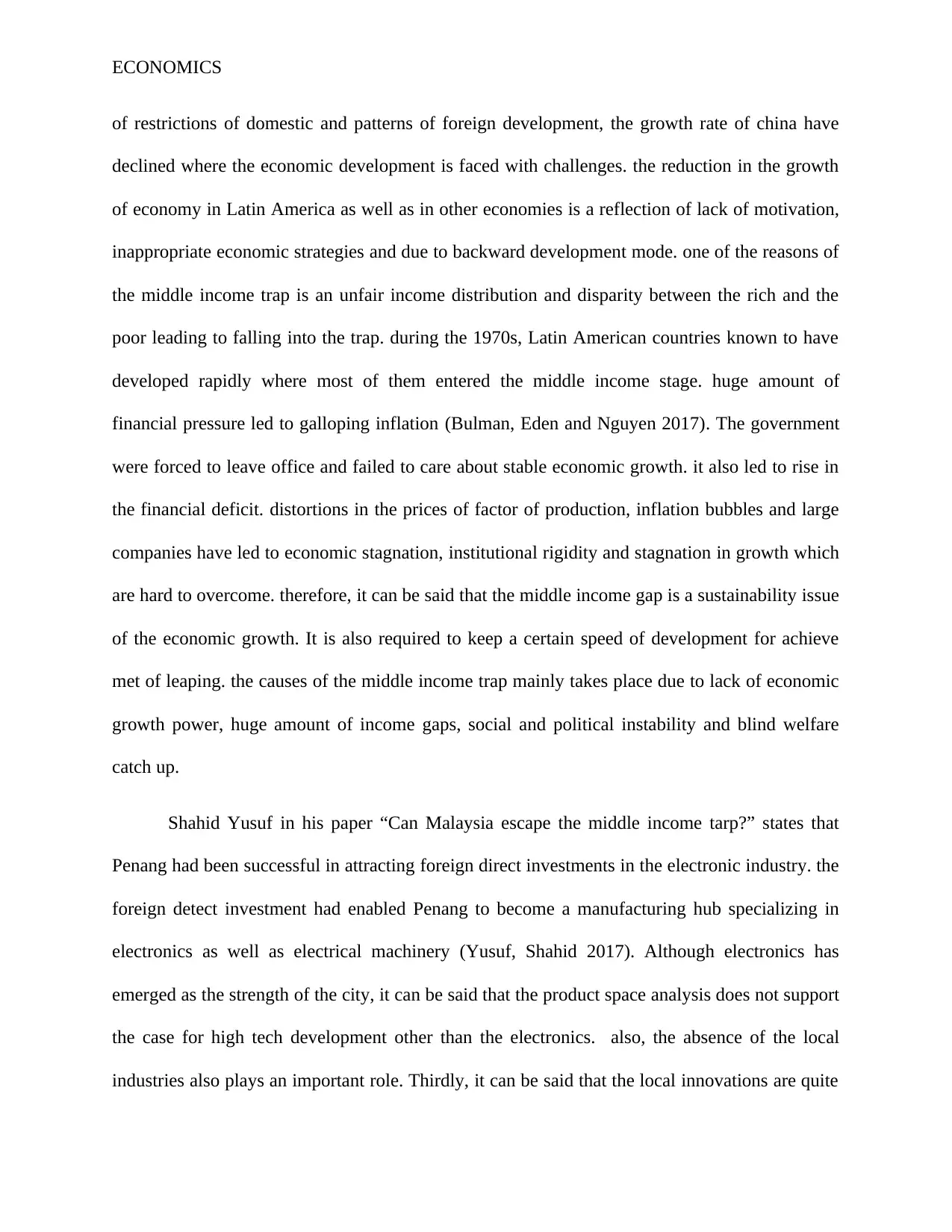
ECONOMICS
of restrictions of domestic and patterns of foreign development, the growth rate of china have
declined where the economic development is faced with challenges. the reduction in the growth
of economy in Latin America as well as in other economies is a reflection of lack of motivation,
inappropriate economic strategies and due to backward development mode. one of the reasons of
the middle income trap is an unfair income distribution and disparity between the rich and the
poor leading to falling into the trap. during the 1970s, Latin American countries known to have
developed rapidly where most of them entered the middle income stage. huge amount of
financial pressure led to galloping inflation (Bulman, Eden and Nguyen 2017). The government
were forced to leave office and failed to care about stable economic growth. it also led to rise in
the financial deficit. distortions in the prices of factor of production, inflation bubbles and large
companies have led to economic stagnation, institutional rigidity and stagnation in growth which
are hard to overcome. therefore, it can be said that the middle income gap is a sustainability issue
of the economic growth. It is also required to keep a certain speed of development for achieve
met of leaping. the causes of the middle income trap mainly takes place due to lack of economic
growth power, huge amount of income gaps, social and political instability and blind welfare
catch up.
Shahid Yusuf in his paper “Can Malaysia escape the middle income tarp?” states that
Penang had been successful in attracting foreign direct investments in the electronic industry. the
foreign detect investment had enabled Penang to become a manufacturing hub specializing in
electronics as well as electrical machinery (Yusuf, Shahid 2017). Although electronics has
emerged as the strength of the city, it can be said that the product space analysis does not support
the case for high tech development other than the electronics. also, the absence of the local
industries also plays an important role. Thirdly, it can be said that the local innovations are quite
of restrictions of domestic and patterns of foreign development, the growth rate of china have
declined where the economic development is faced with challenges. the reduction in the growth
of economy in Latin America as well as in other economies is a reflection of lack of motivation,
inappropriate economic strategies and due to backward development mode. one of the reasons of
the middle income trap is an unfair income distribution and disparity between the rich and the
poor leading to falling into the trap. during the 1970s, Latin American countries known to have
developed rapidly where most of them entered the middle income stage. huge amount of
financial pressure led to galloping inflation (Bulman, Eden and Nguyen 2017). The government
were forced to leave office and failed to care about stable economic growth. it also led to rise in
the financial deficit. distortions in the prices of factor of production, inflation bubbles and large
companies have led to economic stagnation, institutional rigidity and stagnation in growth which
are hard to overcome. therefore, it can be said that the middle income gap is a sustainability issue
of the economic growth. It is also required to keep a certain speed of development for achieve
met of leaping. the causes of the middle income trap mainly takes place due to lack of economic
growth power, huge amount of income gaps, social and political instability and blind welfare
catch up.
Shahid Yusuf in his paper “Can Malaysia escape the middle income tarp?” states that
Penang had been successful in attracting foreign direct investments in the electronic industry. the
foreign detect investment had enabled Penang to become a manufacturing hub specializing in
electronics as well as electrical machinery (Yusuf, Shahid 2017). Although electronics has
emerged as the strength of the city, it can be said that the product space analysis does not support
the case for high tech development other than the electronics. also, the absence of the local
industries also plays an important role. Thirdly, it can be said that the local innovations are quite
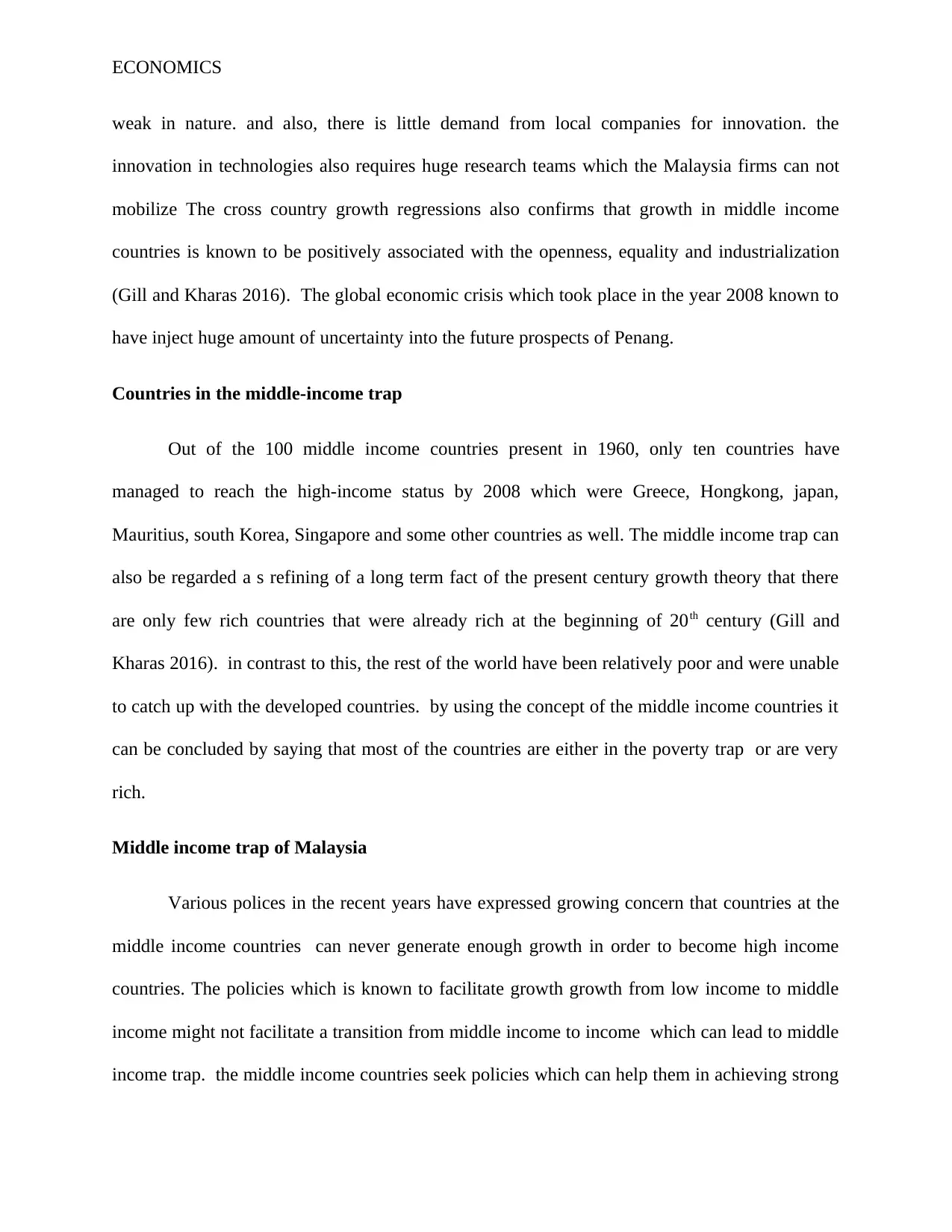
ECONOMICS
weak in nature. and also, there is little demand from local companies for innovation. the
innovation in technologies also requires huge research teams which the Malaysia firms can not
mobilize The cross country growth regressions also confirms that growth in middle income
countries is known to be positively associated with the openness, equality and industrialization
(Gill and Kharas 2016). The global economic crisis which took place in the year 2008 known to
have inject huge amount of uncertainty into the future prospects of Penang.
Countries in the middle-income trap
Out of the 100 middle income countries present in 1960, only ten countries have
managed to reach the high-income status by 2008 which were Greece, Hongkong, japan,
Mauritius, south Korea, Singapore and some other countries as well. The middle income trap can
also be regarded a s refining of a long term fact of the present century growth theory that there
are only few rich countries that were already rich at the beginning of 20th century (Gill and
Kharas 2016). in contrast to this, the rest of the world have been relatively poor and were unable
to catch up with the developed countries. by using the concept of the middle income countries it
can be concluded by saying that most of the countries are either in the poverty trap or are very
rich.
Middle income trap of Malaysia
Various polices in the recent years have expressed growing concern that countries at the
middle income countries can never generate enough growth in order to become high income
countries. The policies which is known to facilitate growth growth from low income to middle
income might not facilitate a transition from middle income to income which can lead to middle
income trap. the middle income countries seek policies which can help them in achieving strong
weak in nature. and also, there is little demand from local companies for innovation. the
innovation in technologies also requires huge research teams which the Malaysia firms can not
mobilize The cross country growth regressions also confirms that growth in middle income
countries is known to be positively associated with the openness, equality and industrialization
(Gill and Kharas 2016). The global economic crisis which took place in the year 2008 known to
have inject huge amount of uncertainty into the future prospects of Penang.
Countries in the middle-income trap
Out of the 100 middle income countries present in 1960, only ten countries have
managed to reach the high-income status by 2008 which were Greece, Hongkong, japan,
Mauritius, south Korea, Singapore and some other countries as well. The middle income trap can
also be regarded a s refining of a long term fact of the present century growth theory that there
are only few rich countries that were already rich at the beginning of 20th century (Gill and
Kharas 2016). in contrast to this, the rest of the world have been relatively poor and were unable
to catch up with the developed countries. by using the concept of the middle income countries it
can be concluded by saying that most of the countries are either in the poverty trap or are very
rich.
Middle income trap of Malaysia
Various polices in the recent years have expressed growing concern that countries at the
middle income countries can never generate enough growth in order to become high income
countries. The policies which is known to facilitate growth growth from low income to middle
income might not facilitate a transition from middle income to income which can lead to middle
income trap. the middle income countries seek policies which can help them in achieving strong
Paraphrase This Document
Need a fresh take? Get an instant paraphrase of this document with our AI Paraphraser
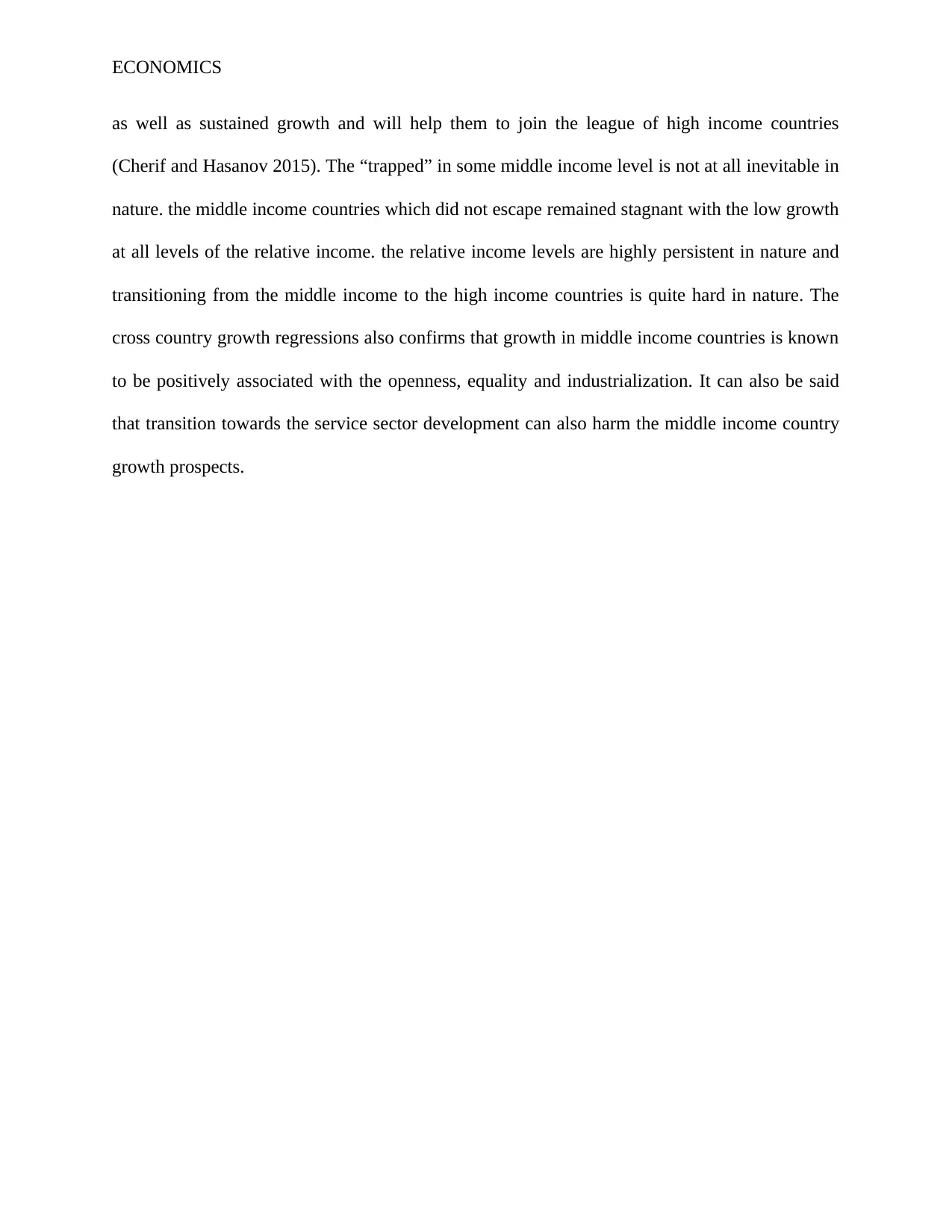
ECONOMICS
as well as sustained growth and will help them to join the league of high income countries
(Cherif and Hasanov 2015). The “trapped” in some middle income level is not at all inevitable in
nature. the middle income countries which did not escape remained stagnant with the low growth
at all levels of the relative income. the relative income levels are highly persistent in nature and
transitioning from the middle income to the high income countries is quite hard in nature. The
cross country growth regressions also confirms that growth in middle income countries is known
to be positively associated with the openness, equality and industrialization. It can also be said
that transition towards the service sector development can also harm the middle income country
growth prospects.
as well as sustained growth and will help them to join the league of high income countries
(Cherif and Hasanov 2015). The “trapped” in some middle income level is not at all inevitable in
nature. the middle income countries which did not escape remained stagnant with the low growth
at all levels of the relative income. the relative income levels are highly persistent in nature and
transitioning from the middle income to the high income countries is quite hard in nature. The
cross country growth regressions also confirms that growth in middle income countries is known
to be positively associated with the openness, equality and industrialization. It can also be said
that transition towards the service sector development can also harm the middle income country
growth prospects.
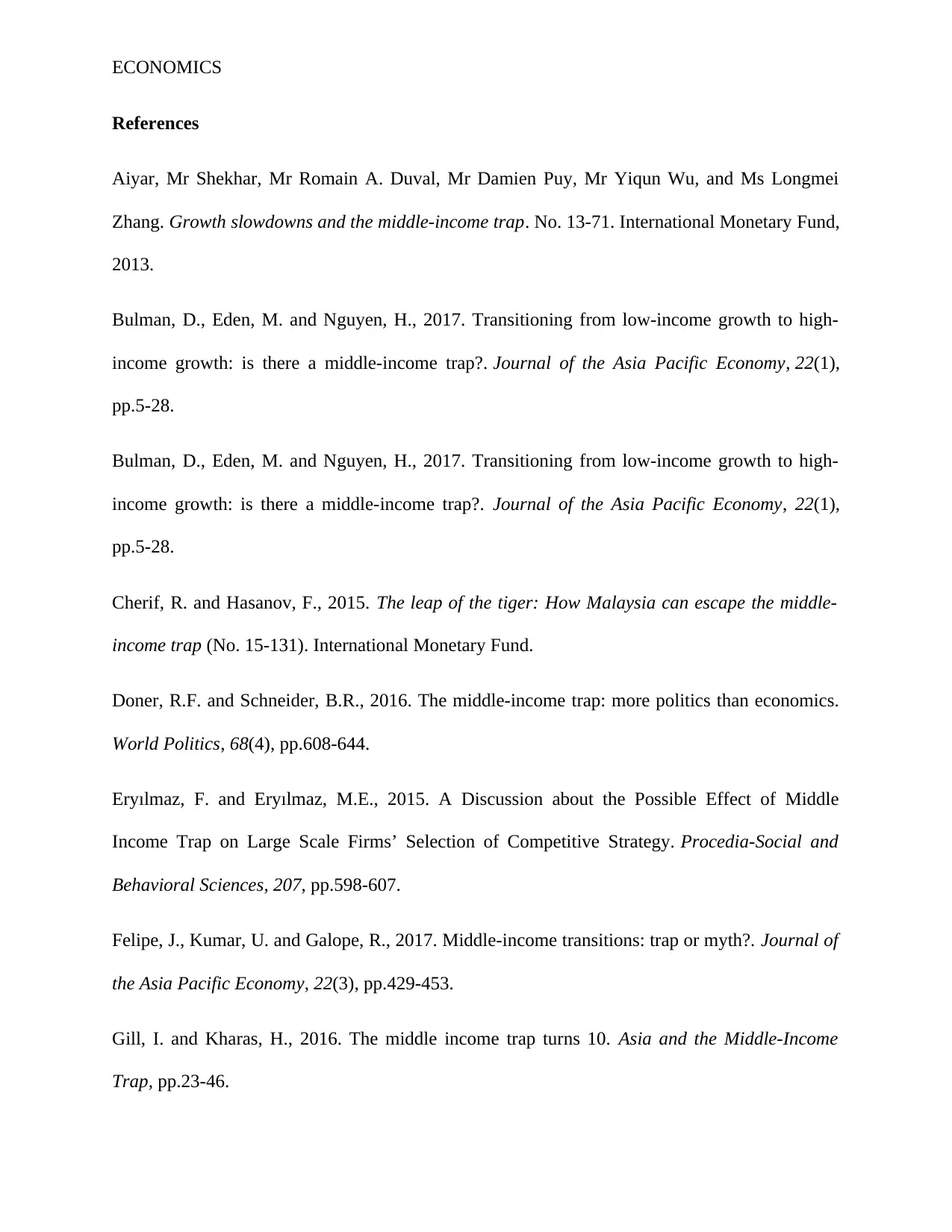
ECONOMICS
References
Aiyar, Mr Shekhar, Mr Romain A. Duval, Mr Damien Puy, Mr Yiqun Wu, and Ms Longmei
Zhang. Growth slowdowns and the middle-income trap. No. 13-71. International Monetary Fund,
2013.
Bulman, D., Eden, M. and Nguyen, H., 2017. Transitioning from low-income growth to high-
income growth: is there a middle-income trap?. Journal of the Asia Pacific Economy, 22(1),
pp.5-28.
Bulman, D., Eden, M. and Nguyen, H., 2017. Transitioning from low-income growth to high-
income growth: is there a middle-income trap?. Journal of the Asia Pacific Economy, 22(1),
pp.5-28.
Cherif, R. and Hasanov, F., 2015. The leap of the tiger: How Malaysia can escape the middle-
income trap (No. 15-131). International Monetary Fund.
Doner, R.F. and Schneider, B.R., 2016. The middle-income trap: more politics than economics.
World Politics, 68(4), pp.608-644.
Eryılmaz, F. and Eryılmaz, M.E., 2015. A Discussion about the Possible Effect of Middle
Income Trap on Large Scale Firms’ Selection of Competitive Strategy. Procedia-Social and
Behavioral Sciences, 207, pp.598-607.
Felipe, J., Kumar, U. and Galope, R., 2017. Middle-income transitions: trap or myth?. Journal of
the Asia Pacific Economy, 22(3), pp.429-453.
Gill, I. and Kharas, H., 2016. The middle income trap turns 10. Asia and the Middle‐Income
Trap, pp.23-46.
References
Aiyar, Mr Shekhar, Mr Romain A. Duval, Mr Damien Puy, Mr Yiqun Wu, and Ms Longmei
Zhang. Growth slowdowns and the middle-income trap. No. 13-71. International Monetary Fund,
2013.
Bulman, D., Eden, M. and Nguyen, H., 2017. Transitioning from low-income growth to high-
income growth: is there a middle-income trap?. Journal of the Asia Pacific Economy, 22(1),
pp.5-28.
Bulman, D., Eden, M. and Nguyen, H., 2017. Transitioning from low-income growth to high-
income growth: is there a middle-income trap?. Journal of the Asia Pacific Economy, 22(1),
pp.5-28.
Cherif, R. and Hasanov, F., 2015. The leap of the tiger: How Malaysia can escape the middle-
income trap (No. 15-131). International Monetary Fund.
Doner, R.F. and Schneider, B.R., 2016. The middle-income trap: more politics than economics.
World Politics, 68(4), pp.608-644.
Eryılmaz, F. and Eryılmaz, M.E., 2015. A Discussion about the Possible Effect of Middle
Income Trap on Large Scale Firms’ Selection of Competitive Strategy. Procedia-Social and
Behavioral Sciences, 207, pp.598-607.
Felipe, J., Kumar, U. and Galope, R., 2017. Middle-income transitions: trap or myth?. Journal of
the Asia Pacific Economy, 22(3), pp.429-453.
Gill, I. and Kharas, H., 2016. The middle income trap turns 10. Asia and the Middle‐Income
Trap, pp.23-46.
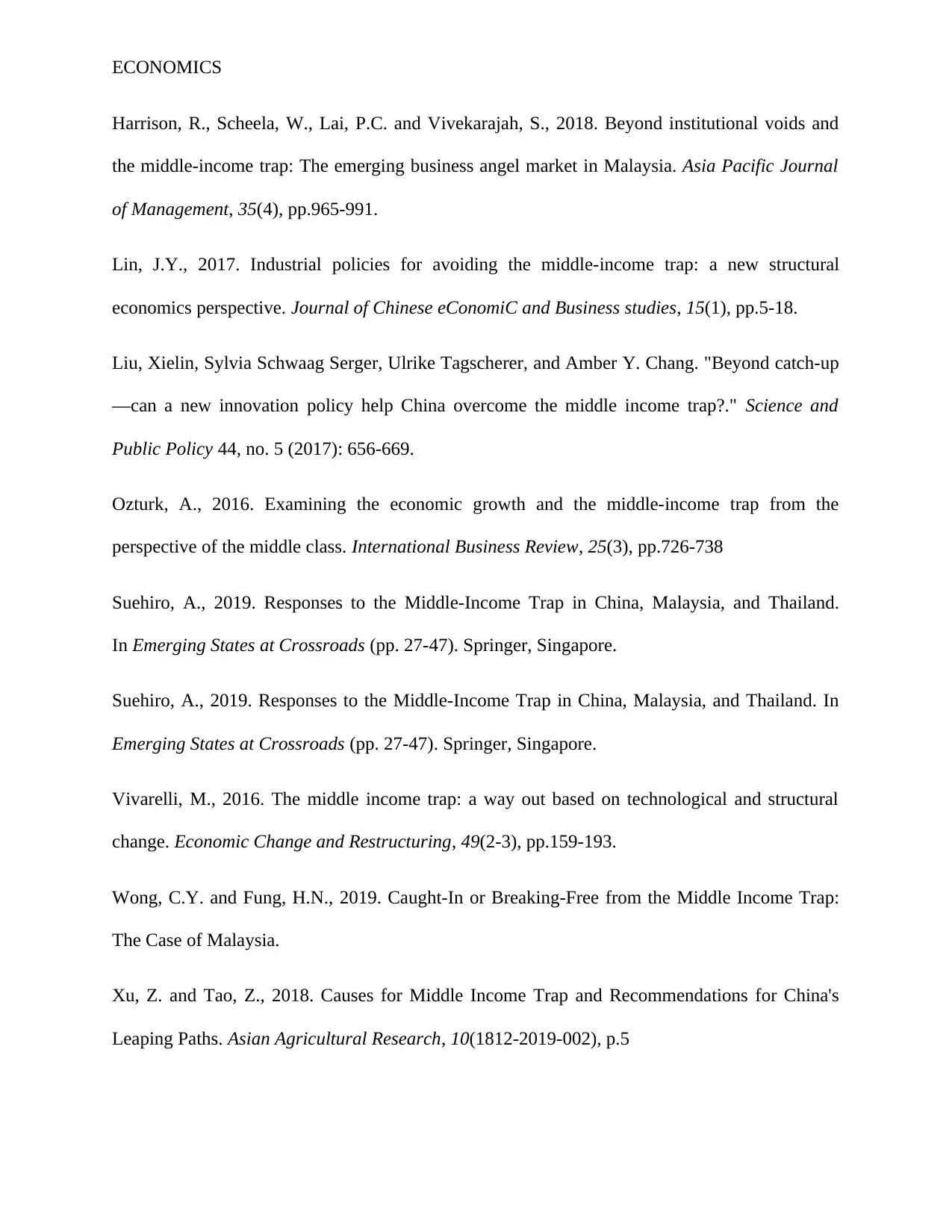
ECONOMICS
Harrison, R., Scheela, W., Lai, P.C. and Vivekarajah, S., 2018. Beyond institutional voids and
the middle-income trap: The emerging business angel market in Malaysia. Asia Pacific Journal
of Management, 35(4), pp.965-991.
Lin, J.Y., 2017. Industrial policies for avoiding the middle-income trap: a new structural
economics perspective. Journal of Chinese eConomiC and Business studies, 15(1), pp.5-18.
Liu, Xielin, Sylvia Schwaag Serger, Ulrike Tagscherer, and Amber Y. Chang. "Beyond catch-up
—can a new innovation policy help China overcome the middle income trap?." Science and
Public Policy 44, no. 5 (2017): 656-669.
Ozturk, A., 2016. Examining the economic growth and the middle-income trap from the
perspective of the middle class. International Business Review, 25(3), pp.726-738
Suehiro, A., 2019. Responses to the Middle-Income Trap in China, Malaysia, and Thailand.
In Emerging States at Crossroads (pp. 27-47). Springer, Singapore.
Suehiro, A., 2019. Responses to the Middle-Income Trap in China, Malaysia, and Thailand. In
Emerging States at Crossroads (pp. 27-47). Springer, Singapore.
Vivarelli, M., 2016. The middle income trap: a way out based on technological and structural
change. Economic Change and Restructuring, 49(2-3), pp.159-193.
Wong, C.Y. and Fung, H.N., 2019. Caught-In or Breaking-Free from the Middle Income Trap:
The Case of Malaysia.
Xu, Z. and Tao, Z., 2018. Causes for Middle Income Trap and Recommendations for China's
Leaping Paths. Asian Agricultural Research, 10(1812-2019-002), p.5
Harrison, R., Scheela, W., Lai, P.C. and Vivekarajah, S., 2018. Beyond institutional voids and
the middle-income trap: The emerging business angel market in Malaysia. Asia Pacific Journal
of Management, 35(4), pp.965-991.
Lin, J.Y., 2017. Industrial policies for avoiding the middle-income trap: a new structural
economics perspective. Journal of Chinese eConomiC and Business studies, 15(1), pp.5-18.
Liu, Xielin, Sylvia Schwaag Serger, Ulrike Tagscherer, and Amber Y. Chang. "Beyond catch-up
—can a new innovation policy help China overcome the middle income trap?." Science and
Public Policy 44, no. 5 (2017): 656-669.
Ozturk, A., 2016. Examining the economic growth and the middle-income trap from the
perspective of the middle class. International Business Review, 25(3), pp.726-738
Suehiro, A., 2019. Responses to the Middle-Income Trap in China, Malaysia, and Thailand.
In Emerging States at Crossroads (pp. 27-47). Springer, Singapore.
Suehiro, A., 2019. Responses to the Middle-Income Trap in China, Malaysia, and Thailand. In
Emerging States at Crossroads (pp. 27-47). Springer, Singapore.
Vivarelli, M., 2016. The middle income trap: a way out based on technological and structural
change. Economic Change and Restructuring, 49(2-3), pp.159-193.
Wong, C.Y. and Fung, H.N., 2019. Caught-In or Breaking-Free from the Middle Income Trap:
The Case of Malaysia.
Xu, Z. and Tao, Z., 2018. Causes for Middle Income Trap and Recommendations for China's
Leaping Paths. Asian Agricultural Research, 10(1812-2019-002), p.5
Secure Best Marks with AI Grader
Need help grading? Try our AI Grader for instant feedback on your assignments.

ECONOMICS
Yusuf, Shahid 2017. "Middle‐income countries: trapped or merely slowing?." Asian‐Pacific
Economic Literature 31, no. 2 : 19-29.
Yusuf, Shahid 2017. "Middle‐income countries: trapped or merely slowing?." Asian‐Pacific
Economic Literature 31, no. 2 : 19-29.
1 out of 11
Related Documents
Your All-in-One AI-Powered Toolkit for Academic Success.
+13062052269
info@desklib.com
Available 24*7 on WhatsApp / Email
![[object Object]](/_next/static/media/star-bottom.7253800d.svg)
Unlock your academic potential
© 2024 | Zucol Services PVT LTD | All rights reserved.




